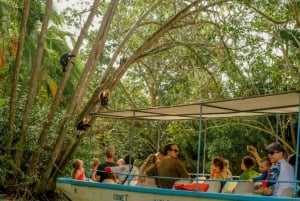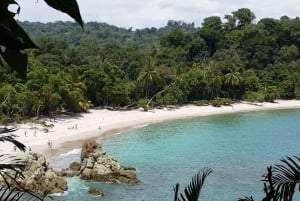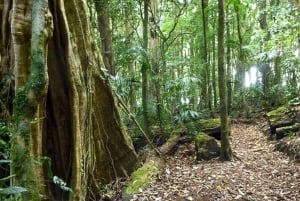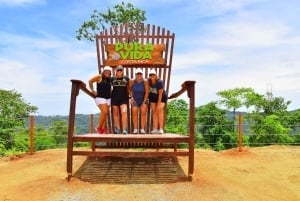History of Costa Rica
Costa Rica has a rich history that is vastly different from the other countries located on the isthmus of
Central America. Costa Rica was inhabited by nomadic tribes before Spanish colonization and then became the poorest and most remote Spanish colony in Central America because of it's distance from the center of power in Guatemala to the north, and the lack of riches it was able to produce for the Crown in Spain. The extreme differences of Costa Rica's past have given it a unique culture, government, and people. Costa Ricans are very proud of their remarkable heritage of avoiding cycles of dictatorship and poverty, and for beating the odds to become a stable
democracy with the highest standard of living of any county in Central America.
Pre-Colonization / Nomadic Tribes
Archaeologists found that civilization had existed in Costa Rica for thousands of years before Columbus arrived on September 18th, 1502. Although there were roughly 20 tribes in Costa Rica at the time, the four main tribes were the Borucas, Chibchas, and Diquis in the southwest, and the tenacious Caribs along the east coast. Numbering only a few hundred thousand in 1502, none of these tribes lasted in large numbers after the arrival of the Spanish. The lack of available workers forced colonialists to bring slaves in from the surrounding islands of the Caribbean.
Costa Rica's indigenous tribes were organized into chiefdoms which indicate there was a hierarchy that included healers, warriors, laborers, and slaves. These small autonomous groups were advanced in metalwork, weaving, and ceramics. They lived in smaller communities unlike the larger and more populated ones of
Mesoamericans to the north, and the Incas of South America. The high mountains and swampy lowlands of what is now Costa Rica, separated these two larger civilizations and made travel between the North and South difficult, and Costa Rica isolated. Interesting archaeological finds throughout Costa Rica offer a glimpse into the lives of these indigenous tribes. Perhaps the largest find is the ancient city of Guayabo that is thought to have housed up to 1,100 residents from approximately 1,000 b.c. to a.d. 1,400. This was an advanced city with wide stone walkways and water cisterns fed by aqueducts. The least understood, and maybe the wildest of all finds, are the perfectly rounds granite spheres called "
bolas" on southern Costa Rica. There are many theories on how these bolas, some as small as a basketball and others as large as a small bus, arrived in southern Costa Rica. Whether it was unparalleled craftsmanship for the time or Aliens marking their landing spot, they are truly amazing and difficult to understand.
Colonization / Spanish Rule
A hurricane damaged Christopher Columbus's ship in 1502 forcing him to make repairs along the beach at Isla Uvita, just off the coast of what is today known as, Puerto Limon. He took the opportunity to explore the thick jungle and trade with the local inhabitants. Upon leaving he immediately petitioned the Spanish Crown to appoint him governor, telling stories of having seen more gold over 2 days in Costa Rica, than he did over 4 years in Espanola.
Christopher Columbus was denied the appointment and later died in 1506. His stories lived on and led many other Spanish conquistadors to follow in his footsteps, seeking the gold he so fondly spoke of. First to follow Columbus was Diego de Nicuesa. The king burdened him with the mission to govern Costa Rica. He was shipwrecked off the Panamanian coast and had to make his way north over land. The trek proved difficult and half of his expedition was killed by disease and natives using guerrilla tactics. He soon gave up and returned to Spain. Costa Rica was then left to the Natives for many years while the Spanish searched for more accessible riches elsewhere. Finally in 1565 Juan Vasquez de Coronado was named governor of Costa Rica after Spain was able to establish the city of Cartago a year earlier. Cartago remained the capital of Costa Rica until 1823.
The early days of Spanish rule were very hard, Costa Rica was nothing like the other colonies that dotted the isthmus. Costa Rica continued to play a minor role in Central America politics. It was virtually detached from the Spanish center of power in Guatemala, and was forbidden by law to trade with other colonies to the south. It was once said by a Spanish governor that Costa Rica was "the poorest and most miserable Spanish colony in all America" Most attribute this to the lack of indigenous people to work as a labor force. No slaves meant that Costa Ricans had to plant their own crops and manage their own land which prohibited the establishment of large plantations that were common in the more affluent colonies. Costa Rica was overlooked, undervalued and left on its own to survive. These seemingly minor things may have helped Costa Ricans become an independent people that would eventually transform its culture into the most well educated, and richest in Central America once Spanish rule ended on September 15th, 1821.
Independence / Viva Costa Rica
When Spain lost the Mexican War of Independence (1810-1821) the Spanish authorities in Guatemala granted freedom to all of Central America, including Costa Rica on September 15th. Costa Rica became a part of the short lived Mexican empire for roughly 2 years, then joined the "The Federal Republic of Central America" in 1823. This Republic was modeled after the United States of America but would not last long. The union started to dissolve when Honduras, Nicaragua, and Costa Rica separated from the republic in 1838. A pattern of isolationism similar to that of the colonial period was reintroduced, and Costa Ricans have since shown little interest in joining other unions of any kind with very few exceptions.
Costa Rica quickly became aware that coffee was a profitable export and farmers quickly realized that they could eke out a living by planting hillsides and small patches of land with what was soon to become a leading export. The famous Costa Rican oxcart has been carrying coffee from the central valley to the coast so that it could be shipped to the the US and Europe since the 1840's.
Isolationism didn't always work. In 1825, the region that is now known as the province of Guanacaste seceded from Nicaragua and merged with Costa Rica. This move created strife in the area until the "Boundary Treaty" of 1896. Another threat from the north came in the form of American
William Walker, and his desire to establish a slaveholding empire in Central America. After many battles, Costa Rican soldiers finally drove him back into the Nicaraguan town of Rivas, where Juan Santamaria set fire to his headquarters and became a national hero.
Under General Tomas Guardia who ruled Costa Rica from 1870 until 1882, Costa Rica curtailed liberty and added to the national debt, but also increased sugar and coffee exports and built schools across the country. In 1871, a new constitution was adopted and remained in effect until 1949 except for a 2 year period between 1917 and 1919. While more exports were being shipped out of Costa Rica, the interior transportation system was being strained. Minor C. Keith made a fortune by opening a rail line between Cartago and Limon. He then entered the banana business and by the late 1900's Keith, and investors formed the United Fruit Company, which pushed bananas within reach of taking over coffee as the leading export.
Civil war broke out in 1948 after Dr. Rafael Angel Calderon of the United Social Christian Party failed to relinquish power after losing the presidential election. Figueres Ferrer managed to defeat Calederon in less than 2 months, restoring peace to Costa Rica and eventually, becoming on it's most influential leaders forming the Founding Junta of the Second Republic of Costa Rica and later becoming president. Under Ferrrer's leadership Costa Rica women and blacks were given the right to vote, the communist party was banned, banks were nationalized, and presidential term limits were established. Ferrer paved the way for another great Costa Rican president, Oscar Arias, who was awarded the Nobel Peace Prize in 1987 for his work to help end the Nicaraguan civil war. Both the Sandinistas and the Contras set up bases in the northern areas of Costa Rica during that conflict. Arias was able to establish peace with all 5 of the Central American presidents signing the treaty. Central America has been at peace since.
Images of Christopher Comumbus, Indian Drummers, and The Map of Central America are under public domain PD-US











